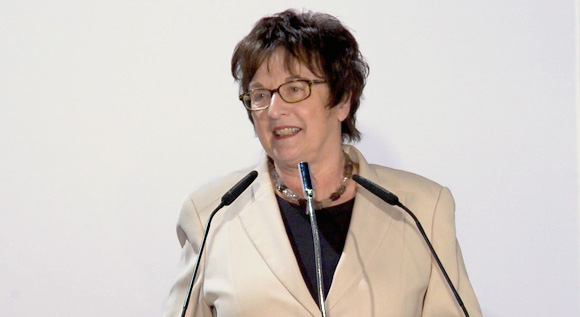“We will pave the way for landlord-to-tenant electricity supply”, says Minister Zypries.
Federal Minister for Economic Affairs and Energy Brigitte Zypries talks about the urgent need for grid expansion and about the planned introduction of a landlord-to-tenant electricity supply model.
 © BMWi
© BMWi
During her keynote speech at the New Year’s reception of the German Renewable Energy Federation, Minister Zypries said that grid expansion projects needed to be approved more quickly. She also used her speech, held in Berlin on 16 February 2017, to make the following comment: “It is great to see that renewables expansion is making headway, but the problem is that grid expansion is not moving forward at the same speed.” She went on to say that generating electricity that could not be transported to consumers made little sense.
“The only way we can solve this problem in the long term is to speed up grid expansion”, the Minister said. She declared that the main direct current cables transporting electricity from the North to the South of Germany needed to be constructed by 2025, that the responsibility for this resided with the Federal Government and that everything would be done to drive forward grid expansion as quickly as possible. She also said that by giving priority to the use of underground cables, an important milestone had been reached, but that until construction of the main cables had been completed, the amount of electricity that could be transported depended on the extent to which the ‘starting grid’ was expanded. Responsibility for this typically lies with the German Länder.
Federal Government to pass legislation on landlord-to-tenant electricity supply before the end of this legislative term
In her speech, Brigitte Zypries also announced that she would bring forward a bill on landlord-to-tenant electricity supply. “We want tenants to share in the benefits of renewables expansion”, she stated. She went on to say that the coalition had agreed on a number of key points that the future landlord-to-tenant electricity supply model would be designed around. The bill on this model is to be adopted by Parliament before the end of this legislative term.
Landlord-to-tenant electricity supply means that landlords install, for example, a photovoltaics system on the roof of a residential building they own. The energy generated by the PV system is then supplied to the tenants of this building. In contrast to electricity supplied via the grid, the electricity supplied from such systems is not subject to grid charges, grid-related levies, electricity taxes or concession fees. However, the renewable energy surcharge needs to be paid. If users do not use up all of the electricity generated, the remaining volumes are fed into the grid and landlords are reimbursed for this. Supplying tenants with renewable energy is currently not a profitable business model as landlords who do this face additional costs for the metering, selling, and billing of the electricity they supply. The Federal Government wants to change this by providing better funding in order to ensure that both tenants and landlords join in the energy transition.

